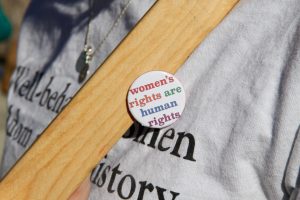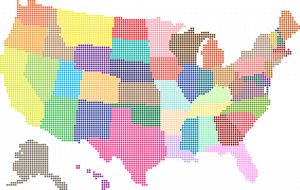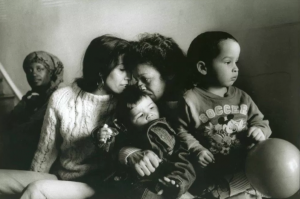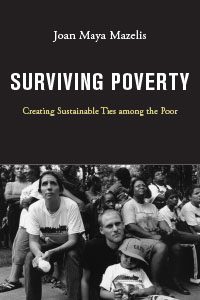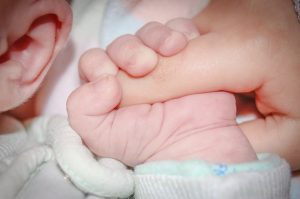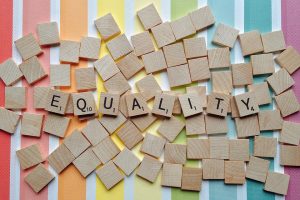
On August 26, 2017, Women’s Equality Day Turned 44.
A fact sheet compiled for the Council on Contemporary Families by Nika Fate-Dixon and Stephanie Coontz, The Evergreen State College. Executive summary/advisory available.
Ninety-seven years ago on Saturday, August 26, Congress certified the 19th Amendment to the Constitution, granting American women the vote. Since 1973, August 26th has been designated as Women’s Equality Day, offering a chance to assess the current status of gender equity. The past three decades have seen continued gains in women’s educational and occupational achievements and a striking increase in egalitarian arrangements on the home front. But progress has not been the same for women of color as for white women; it has stalled for parents; and there have been serious setbacks in the political realm. Additionally, class differences among women have widened. The latest research on trends in education, work, family, and political directions raises new questions about where we are headed.
EDUCATION AND WORK: Gains in Education, Occupations, and Pay. Substantial Inequalities Connected to Race, Class, and also to Sexist Work Cultures
Overall, the wage gap has improved significantly. In 2015, according to a Pew analysis of median hourly earnings of both full-and part-time U.S. workers, women earned 83 percent of what men earned. This 17-cent gap is half what it was in 1980 (36 cents then).
But how do we interpret these numbers? Comparisons of yearly salaries can understate roll backs in gender discrimination when they don’t take into account differences in the number of hours men and women work. Comparing hourly pay also has its limits but suggests more steady progress, particularly for young women (ages 25 – 34). In 1980, their hourly wages were just 67 percent of their male peers’. Thirty-five years later, they have reached 90 percent.
The raw ratios in some ways overstate progress. An analysis of the Current Population Survey newly conducted for this report by University of Maryland sociologist Philip Cohen, suggests that women have made gains largely by increasing their education level relative to men. Among people age 25 to 54 who worked at least half time and half the year, 44 percent of women in 2016 have a BA or higher education, compared with 37 percent of men – an advantage for women that has opened up since 2001. His analysis of the wage gap among those same workers shows that for those with a BA or more, women earn 80 percent of men’s wages, when statistically controlling for age, race/ethnicity, marital status, and the presence of children. That is unchanged since 1992. For those with less than a BA degree, women have made slight progress during that time, from 77 percent to 79 percent. Despite important exceptions, then, the overall narrowing of the wage gap since the early 1990s is partly a function of women’s increasing education levels rather than greater equality among workers with comparable levels of education. (For details of the analysis see this.)
Additionally, despite men’s continued pay advantage, their wages have been declining since 1979 and this decline accounts for almost a quarter of the reduction in the gender wage gap. According to 2016 data of median hourly wages, women today earn almost a third more than women did in 1979, while men today earn 4 percent less. For men with a high school degree, real wages have fallen by more than 14 percent since 1979. Women’s earnings started from such a much lower base that they remain below those of men doing the same or comparable jobs and with the same levels of educational achievement. But high-earning women (discussed below) have greatly increased the gap between themselves and low earners of both sexes.
Persistence of racial inequalities means the gender wage gap is not same for all groups. The earnings of women across all races and ethnicities lag behind those of white men as well as those of men in their own racial or ethnic group, but white and Asian women have narrowed the wage gap with white men to a much greater degree than have black and Hispanic women. Between 1980 and 2015, the gap in median hourly earnings between white men and white women narrowed by 22 cents. In comparison, the gap between black women and white men declined by only 9 cents: Black women earned 65 cents for every dollar white men earned in 2015. Hispanic women fared worse, narrowing the gap by just 5 cents during that time. As of 2015, the average Hispanic woman earned 58 cents for every dollar the average white man took home. Asian women, by contrast, made 87 cents for every dollar earned by a white man.
These patterns of racial inequality differ by gender. The wage gap between white men and black and Hispanic men, unlike that between men and women of all races combined, has not narrowed since 1980. As of 2015, black men earned the same 73 percent share of white men’s hourly earnings as they did in 1980, and Hispanic men earned slightly less — 69 percent of white men’s earnings in 2015, compared to 71 percent in 1980. On the other hand, Asian men now earn more per hour than white men, although this is largely driven by differences in the percentage of highly-educated individuals in each group.
Class and income inequality complicates the picture. Despite the huge gains high-earning women have made in comparison to people at the middle and bottom, the largest gender pay gap is between the highest earning men and women (see page 3 and Table 1 in linked document). In the early 80s, women in high-paid jobs lagged behind men less than women in middle-wage occupations. Since 2010, however, women’s pay relative to men’s among top earners has been considerably less than that of women in the middle (and bottom) of the distribution (also on page 3). These developments reflect the growing advantage among the top ten, one, and 0.1 percent of earners, most of whom are men. So even as the earnings of women in the top 20 percent have not, overall, kept up with those of men in the same earnings category, their position relative to middle-earning men has greatly improved. It used to be that the highest-earning woman earned no more than the average-earning man. Today, however, women at the top make more than 1.5 times as much as the typical man.
Gender gap among high-earners is about sexism more than choice. The gender wage gap between high-earning men and women is often blamed on the fact that women tend to major in subjects that lead to less lucrative jobs, such as those in teaching and social work. But women actually outnumber men in the biosciences and there is little to no gender difference in the social sciences and mathematics. The only STEM fields of study in which men hugely outnumber women are computer science and engineering, which are more than 80 percent male.
We cannot attribute the low representation of women in technology and engineering to women’s preferences in majors. For one thing, recent studies find that teachers start favoring boys over girls as early as first grade. These and other subtle discriminatory messages lead to early declines in girls’ confidence in their intellectual abilities.
Even more important is the pervasive culture of sexism and an exceptionally lopsided rewards system in many male-dominated occupations; women under 25 in the tech industry earn, on average, 29 percent less than their male counterparts, and women of all ages receive lower salary offers than men for the same job at the same company more than 60 percent of the time. Such factors discourage women from persisting. While women obtain nearly 20 percent of engineering degrees, only 11 percent of practicing engineers are women. Women tech workers are twice as likely as men to quit their jobs.
Low wages follow women around. For all the attention to the glass ceiling in high-earning fields such as finance, law, and technology, the fact is that the typical woman is three times as likely as the average man to work in occupations with poverty-level wages. Women constitute 57 percent of workers paid under $15 per hour and are the majority of low-wage workers in every state.
Considerable research shows that this is not just because women are channeled into low-paying jobs. One study compared the relative pay of different jobs between 1950s and 2000, using national data on hundreds of occupations. The researchers found that when the percentage of female workers in the occupation increased, the same job paid less, suggesting that employers were assessing the job’s value not by its actual demands but by the gender of those doing it.
MARRIAGE, HOUSEWORK, SEX, AND PARENTHOOD: It got better, but inequities persist for moms
For the past 15 years, there has been much hand-wringing about the tensions in dual-earner heterosexual marriages, especially now that one in five wives comes to marriage with higher educational degrees or earnings than their husbands. Pundits have warned women that if they make too many gains in the public world or expect too much of their partners at home, they will not be able to sustain satisfying romantic relationships. For years, many researchers believed that women in dual-earner marriages worked a “second shift” when they came home, and that men who earned less than their wives compensated by doing even less around the house.
Today, however, childless couples divide household labor pretty much equally. In fact, rather than women in such couples coming home to a second shift, men average a slightly longer work week when we count both paid and unpaid hours. Marriage has ceased to have any effect in propelling men into more traditional roles. Marriages in which the wife has more education than her husband are no longer more likely to end in divorce. And, recently the added risk of divorce when women earn more than their husbands has also evaporated. Additionally, new research shows that such women do not, as previously observed, do extra housework to compensate for any “threat” to their husbands, nor do their husbands do less housework or childcare as a reaction to gender status threat.
The gender workload gets more uneven after the birth of a child, despite the fact that fathers have nearly tripled the time they spend with their children, from 2.5 hours in 1965 to 7.3 hours per week today. This includes doubling the developmental care they do (think reading or playing games) and tripling the daily routine physical care that most dads used to leave almost entirely to mothers. Men also spend five more hours per week on household chores than their 1965 counterparts. Furthermore, today’s dads are just as likely as moms to say that parenting is extremely important to their identity.
In sum, dads are pitching in more than ever, yet on average mothers still do more housework and childcare than fathers. Even couples who shared paid work and domestic work equally before having children, and thought they were sharing it equally afterwards, turn out to backslide into more traditional roles. One study of such couples found that they were fully egalitarian before parenthood, and believed they were working the same total hours of work after the birth of a child—but they weren’t. Time diaries revealed that the women had added 22 hours of childcare to their work week while maintaining the same amount of housework and paid work as before. Men had added 14 hours of childcare, eight hours less than their partners, while reducing their housework by five hours.
Ironically, however, the minority of coupled parents who do equally share childcare and housework report higher levels of sexual and marital satisfaction than couples who divide the work less equally. Overall, American couples in the early 2010s report having sex, on average, nine fewer times per year than couples did in the 1990s. But parents who share housework are, on average, having sex more frequently than a quarter of a century ago.
Similar advantages accrue to sharing paid work more equally. Research confirms that the busiest husbands and wives, those who spend more time on housework and paid work, have the most sex. However, the lack of family-friendly work policies and affordable quality childcare in the United States leads many couples, who might otherwise prefer to share breadwinning and childrearing more equally, to fall back into more traditional arrangements.
We are getting mixed messages about how the next generation of parents will handle the tension between the widespread expectation of shared work and family duties and the restricted availability of family-friendly support systems. Some polls suggest a revival of support for traditional family and power relations among high school seniors, although others show strong support among young adults for gender equity. A poll of 14- to 24-year-olds commissioned by MTV found that 92 percent of men and 94 percent of women believed that men and women should not be treated differently because of their gender. On the other hand, women put a higher priority on sharing household responsibilities than did men, and a full 30 percent of men, compared to less than 20 percent of women, said there was little use in pursuing more gender equality because inequalities between men and women will always exist.
POLITICS AND POLICY: Setbacks in Reproductive Rights, Supports for Families with Children, Resources for Single Mothers – While Anti-Female Sentiments Get Louder and More Outrageous
A dramatic setback for women’s rights in recent years has been the steady erosion of reproductive choice. One poll taken this month found that two-thirds of voting age adults support women having access to reproductive health care in their community. Yet the Trump Administration plans to halt funding for a successful national teen pregnancy prevention program, with the 2018 budget including funds solely for abstinence-only sex education.
The August poll also found that six in ten (61 percent) adults would support a federal law, like the Women’s Health Protection Act, that would safeguard abortion care and prevent restrictions that make abortion access increasingly out of reach. Yet over the last six years, states have passed 369 laws mandating such restrictions (see page 1 of linked document).
Although the Trump administration has proposed a six-week paid parental leave program, which would help many families, the deepest cuts projected in the Trump Administration’s 2018 Federal Budget Request target programs that are especially essential to families and to women. Many of these cuts threaten the well-being of men, women, and children alike. They will be especially devastating to single mothers, who are already much more likely to be poor in the United States than in other wealthy countries. The budget slashes $1.7 trillion over the next ten years from programs that support families, including deep cuts to Medicaid, the Children’s Health Insurance Program (CHIP), and the Special Supplemental Nutrition Program for Women, Infants and Children (WIC). Since women comprise two-thirds of all adult Medicaid recipients and almost half of American children get their health care from Medicaid or CHIP, this proposal represents a major setback.
Finally, we cannot ignore the increased visibility and volume of sexist sentiments, from the “grab them by the pussy” tape released during the campaign to the new prominence of Breitbart News, known for headlines such as “Birth Control Makes Women Unattractive and Crazy,” “Would You Rather Your Child Have Feminism or Cancer?” and “The Solution to Online ‘Harassment’ Is Simple: Women Should Log Off”.
It is still an open question as to whether such sexism will reinvigorate the movement for gender equality or encourage others to express even more hostility toward women. But it’s worth noting how extreme the newly invigorated neo-Nazis can be, as in the reaction of Andrew Anglin, editor of the Daily Stormer, to the death of Heather Heyer, the 32-year-old paralegal who was mowed down by a Nazi sympathizer during the August 12 white supremacist demonstration in Charlottesville. Anglin wrote that Heyer’s death relieved society from tolerating yet another “fat, childless, 32-year-old slut… who had failed to do her most basic duty – her only real duty, in fact – and reproduce.”
Most Americans are rightly horrified by such sentiments, but some disturbingly similar sentiments lie behind the attacks on Planned Parenthood and the demonization of feminists made by more cagey social conservatives. So August 26 should not be a day for complacency, even as we recognize the progress women have made.
***
Nika Fate-Dixon is a CCF research intern and a graduate of The Evergreen State College.
Stephanie Coontz is Professor of History at The Evergreen State College and Director of Research and Education for the Council on Contemporary Families. For further information, contact coontzs@msn.com.

